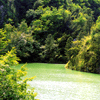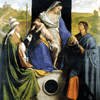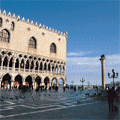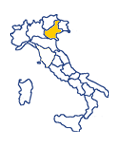|
|
|
Belluno & Veneto Dolomites Guide Italy
|
 |
 |
 |
 |
|
|
|
|
Directories of Web Sites:
Belluno & Veneto Dolomites Italy
Belluno & Veneto Dolomites Hotels
Belluno & Veneto Dolomites Guide
Belluno looks out of a natural balcony onto the Piave valley that opens out enchantingly down beyond the town's neighbourhoods, protected as if by magic by a ring of mountains that gently stand out against the clear blu sky. The breathtaking view forms a magnificent backdrop to this town which is full of nooks and crannies of great historical interest. It is no coincidence that the modern translation of the ancient name of Belluno is "The Shining City", a reference not only to Beleno, the Celtic god of the Sun, but also to the sparkling waters which surround the city (the water was under the Beleno's protection). Dino Buzzati, one of the most famous sons of this capital of the mountain area of the Veneto region, described Belluno as "a marvellous, almost incredible union of the world of Venice (with its serenity, the classical armony of its contours, its timeless elegance, its unique architecture) and the world of the north (the mountains shrouded in mystery, the long winters, the stories, the spirits of the caves and the woods, the intagnible sense of distance, of solitude, ...) ...".
The centre of the City is rich in Art and History. The Cathedral square is picturesque and fascinating. It is overlooked by the palazzi of the Town Hall, the Rettori, the Vescovi and the chapel of Saint Mary of the Graces. The Cattedrale Basilica di San Martino was built in the beginning of the 16th Century, designed by Tullio Lombardo, in Renaissance and Baroque style. The Palazzo dei Rettori, built between the end of the 14th century and the beginning of the 15th, is the seat of the Prefectus, the offices of the representative of the Italian government. The main square of Belluno is Piazza dei Martiri, once called "Campiello". It boasts beautiful gardens and buildings with typical porticoes built between the 16th and the 20th century. The church of Santo Stefano, in Italian-Gothic style, boasts a masterpiece by Cesare VecellioThe meeting between Abraham and Melchisedech".
Perched on the "Colle delle Capre" (Hill of the Goats), Feltre dominates the surrounding countryside and is itself a little treasure trove of history and culture. A stroll down via Mezzaterra, with its splendid frescoed palazzi on either side takes us right back in time; we seem to feel the echoes of the horses and carriages, the rustle of flowing gowns and the distant strains of mandolins. The Museo Civico di Feltre boasts several famous paintings, among them the "Madonna con Bambino, S. Dionisio e S. Eleuterio" by Cima da Conegliano.
Thanks to the Dolomites, Belluno offers, in wintertime, ski runs both for downhill and cross country skiing. The most famous downhill slope is the Nevegal with almost 30 km of pistes that are always covered and in good condition; it also offers the excitement of night-time descents down illuminated slopes. The Nevegal cross country course really grips enthusiasts who want to commune with the silence of the woods.
The Bellunesi Dolomites National Park was established in 1993. It is situated on a mountainous area of 32.000 hectares between Cismon and Piave Valleys. It is the only national park in the North-East of Italy: it is quite vast, and may be extended, one day, in order to cover also the neighbouring Bosconero group, where we can already find a deserted valley, the Tovanella, protected: this valley must be mentioned as recently a few bears have become residents (the animals trekked from the ex-Jugoslavia). As it is, this park includes both mountains groups above Feltre (the Vette, Cimone and Pizzocco peaks), the wild Monti del Sole (Mountains of the Sun) and the beautiful Schiara, above Belluno, the highest peak at 2565 m. But the lowest peaks cannot be absolutely underestimated: the 2186 m high Pizzocco is easy, and it offers a fantastic view over the Dolomites and the Val Belluna, as well as the Serva peak. Both flora and fauna of this park rank among the richest in the whole Alps. The most worthy attraction points are the deep valleys entering the park (the Mis, the Cordevole, or the Canzłi), the large CaiĆda Forest close to Longarone, the forlorn houses of Gena, an abandoned village, and all the outings organized during the summer by the park authorities can be recommended.
The Cansiglio Forest State Reserve is located
down South, where the Dolomites-beyond-the-Piave end. It is a huge plateau at over 1100 m covered by a thick beech and fir forest, one of the pride of the nation. The forest used to be exploited by the most serene Republic of Venice in order to make war and commercial ships (in ancient times Venice used to call it "The (forest which provided) Saint Mark's oars"). Awaiting for a formal and well defined park to be established, now the State manages some 8 reserves, which are to be visited following well marked paths. There is a visitor centre. Apart from the beautiful forest, very impressive during the autumn, a major attraction point is the Bus de la Lum karst abyss, plunging for more than 600 m. Best is to reach the forest from Tambre d'Alpago in the North, or Vittorio Veneto in the South; the visitor should not miss the small museum deducated to the Cimbri, loggers of German origin who settled there two centuries ago. The main village of this area is Pieve d'Alpago. It has always been a privileged vantage point because of the excellent view over Santa Croce lake and the nearby Cansiglio forest. Evidence of its past can be seen in the characteristic stone buildings with sloping roofs, typical of the Alpago area. Today, thanks to its close relationship with the neighbouring mountains, Pieve is placing increasing importance on sports facilities. (Part of the Contents and the Images are gently given by APT Belluno-Feltre-Alpago) |
|
|
|
Acquista la tua visibilità su Travel Plan
|
|
|
|








